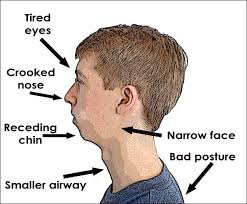 Mouth breathing, or chronic oral ventilation, is long-term breathing through the mouth.
Mouth breathing, or chronic oral ventilation, is long-term breathing through the mouth.
It often is caused by an obstruction to breathing through the nose.
Symptoms of chronic mouth breathing:
snoring, dry mouth, hoarse voice, bad breath, fatigue, sleep apnea.
Chronic mouth breathing is caused by chronic nasal congestion
Treatment of the underlying cause of nasal congestion if present.
The term mouth breather as a pejorative noun that is used to mean a stupid person.
Nasal obstruction classified into three types: obstructive, habitual, and anatomic.
Airway dysfuntion related to mouth breathing starts with an inflammatory reaction then leading to tissue growth in the area which leads to airway obstruction and mouth breathing and then finally an altered face structure.
Nasal breathing produces nitric oxide within the body, while mouth breathing does not.
The nose filters out particles that enter the body, humidifies the air we breathe and warms it to body temperature.
Mouth breathing pulls pollution and germs directly into the lungs.
Dry cold air in the lungs makes the secretions thick, slows the cleaning cilia, and slows down the passage of oxygen into the bloodstream.
As a result, chronic mouth breathing may lead to illness.
About 85% of mouth breathing is an adaptation to nasal congestion.
Mouth breathing frequently occurs during sleep.
Other causes of mouth breathing’
includes: antrochoanal polyps. a short upper lip which prevents the lips from meeting at rest, and pregnancy rhinitis which tends to occur in the third trimester of pregnancy.
Medical conditions associated with mouth breathing:
cheilitis glandularis
Down syndrome
Anterior open bite
Tongue thrusting habit
Cerebral palsy
ADHD,
Sleep apnea,
Snoring.
Gingivitis, and gingival enlargement,
Increased levels of dental plaque.
Anterior maxillary gum region is erythematous, edematous and shiny.
Breathing through the mouth decreases saliva flow, which has minerals to help neutralize bacteria, clean off the teeth, and rehydrate the tissues.
Without adequate saliva the risk of gum disease and cavities increases.
Chronic mouth breathing in children may alter dental and facial growth:
leading to the development of a long, narrow face, sometimes termed long face syndrome.
Conversely a long thin face and thin nasopharyngeal airway predispose to nasal obstruction and mouth breathing.
